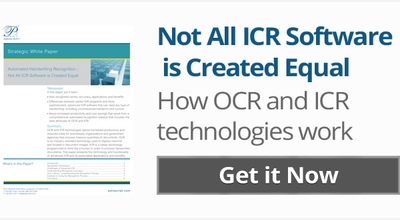Working with good quality machine print, OCR provides recognition accuracy of nearly 100 percent (99.9%). The diversity of human writing styles, spacing variations, irregularities of handwriting – all these factors make handwriting recognition a much more challenging task than reading machine printed or even hand printed characters. Therefore, the recognition systems that read cursive handwriting cannot guarantee the same levels of accuracy that OCR systems deliver on machine print. However, they can meet the most demanding accuracy requirements by implementing highly sophisticated algorithms designed for that specific purpose.
One of the parameters available from a good handwriting recognition system is the acceptance threshold, which allows the user to manipulate the substitution rates over the rejection rates. Generally speaking, a lower acceptance threshold will return more “recognized” answers and contain more errors while a higher acceptance threshold will return less recognized answers that contain fewer errors. Those answers that fell below the acceptance threshold are sent for human verification. This approach does not eliminate human labor but reduces it significantly. Simultaneously it helps to guarantee the accuracy of the accepted answers at the level required by a particular application, and even outperform the accuracy of human operators.
There are multiple factors that influence the read rate and accuracy in each particular case. This may include the quality of images, type of fields, type of documents, availability of the context, and many others. Advanced handwriting recognition systems exploit different powerful mechanisms that allow maximizing accuracy in each particular case. This includes voting mechanism, cross-validation of data, using context information.
Depending on the application, the trade-off between accepted automatically recognized answers and rejected answers that are sent for additional manual verification may vary. For example, the best systems reading amount fields on American checks can reach 90% read rate with 1% error rate. Similarly, the system that the USPS uses to read addresses on envelopes reaches up to 95% read rate at 2% error rate.
Just these systems alone affect practically every American proving that handwriting recognition technology efficiently meets our needs on a daily basis.

